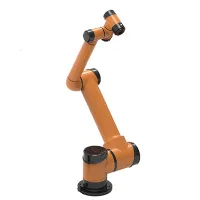AUBO I7 Alternatives & Competitors
Ranked Nr. 134 of 207 Cobots

Top 10 I7 Alternatives
- Elephant Robotics myBuddy 280
- AUBO i10

Elephant Robotics myBuddy 280
Payload 0.25kg | Reach 280mmmyBuddy 280 by Elephant Robotics is a 13 DoF collaborative robot, and a double-arm robot that is considered as the most cost-effective dual-arm robot powered by Raspberry Pi. Each arm of the robot has a payload of 500g, a reach of 280mm, and 6 axes.
The robot's design allows it to work collaboratively with humans, making it ideal for a wide range of applications in small and medium-sized enterprises. The robot's high degree of flexibility and adaptability, along with its low cost, makes it an excellent choice for various tasks such as machine tending, packaging, pick-and-place, and assembly.
The robot is also equipped with a visual programming interface, allowing even those with no prior programming experience to operate it. Its compact size and lightweight make it easy to integrate into existing workflows, and its safety features, such as collision detection and force sensing, ensure safe operation around humans.

AUBO i10
Payload 10kg | Reach 1350mmThe AUBO-i10 is a lightweight collaborative robot designed for human-centric agile manufacturing. With a 10 kg payload and 1350 mm reach, it provides flexibility and ease of integration into various industrial environments. Its six axes allow for a wide range of motion, making it suitable for tasks such as machine tending, assembly, and packaging. The robot's compact design and user-friendly features facilitate quick deployment and adaptation without extensive programming knowledge.
A key feature of the AUBO-i10 is its collaborative functionality, allowing it to operate safely alongside human workers without the need for additional safety equipment, provided a risk assessment is completed. Its hand-guiding teaching method and integrated teach pendant simplify programming and operational adjustments. Safety is reinforced through power and force limiting functions that automatically stop the robot if a collision is detected, and real-time feedback is provided by embedded sensors.
The robot supports open-source architecture, including ROS (Robot Operating System) compatibility, and features a CAN bus network for inter-joint communication. This openness, combined with its low cost of ownership and high positional repeatability, makes the AUBO-i10 an appealing choice for both industrial automation and academic research. Its versatility and ease of reconfiguration contribute to its efficiency in high-mix, low-volume applications.

